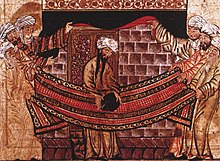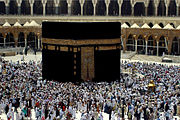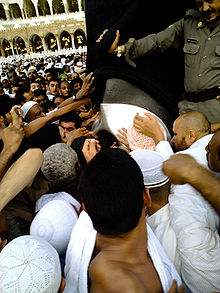Black Stone (Mecca)
The black stone ( Arabic الحجر الأسود, DMG al-ḥaǧar al-aswad ) is a cult stone , which is walled in at the eastern corner of the Kaaba in Mecca and marks the starting point of the Tawāf , the ritual encirclement of this sanctuary. He is worshiped as he walks around the building by kissing, touching or pointing with his hand.
Location, size and physical structure
The black stone is located on the eastern corner of the Kaaba, the so-called "black corner" ( ar-rukn al-aswad ), to the left of its door. It is set into the wall at a height of about 1.5 meters above the ground. Its basic color is reddish black. Broken into several smaller fragments, it is now held together by cement and a silver border. The area inside the silver frame is 20 × 15 cm. In 1825 the stone comprised a total of 15 individual pieces. Today only eight smaller pieces are visible. The largest fragment is the size of a date.
The origin and the physical properties of the black stone are unknown; so far it has not been scientifically investigated. The possibility that it is the remainder of a meteorite is being discussed . There are also speculations that it could be a tektite or agate .
Scheme of the Kaaba -
(1) black stoneView of the black stone with 15 fragments (1894 in W. Muirs Life of Mahomet )
history
The worship of the black stone goes back to the ancient Arabic pagan stone cult . In the course of the Islamization of this ritual, the stone was ascribed a supernatural origin. On the other hand, some fellow prophets were critical of the veneration of the black stone because they saw it as a relic of ancient Arab paganism. For example, it is narrated from Umar ibn al-Chattāb that he kissed the stone when he was in Mecca, but then said: “I know that you are a stone and that you can neither use nor harm. If I hadn't seen the Messenger of God kissing you, I would not have kissed you. "
During the siege of Mecca in October 683, the Black Stone was hit by a catapult projectile and broke into three pieces. The Kaaba also caught fire from a burning catapult projectile. The black stone is said to have received its characteristic black color. After the besiegers left, ʿAbdallāh ibn az-Zubair had the Kaaba rebuilt. During the construction, ʿAbdallāh ibn az-Zubair kept the stone in a locked chest in his house. When the walls were erected up to the height at which the black stone was previously attached, ʿAbdallāh ibn az-Zubair came and inserted the stone himself, putting the three parts together with a silver border.
In 931 the Black Stone was broken out by the Ismaili Qarmatians and deported to Bahrain ; It was not until 951 that he returned to Mecca through the mediation of the Ismaili Fatimids and for a horrific ransom. It is said that it was wrapped with bands of silver in order to hold together the cracks that were created when it broke out, but the said silver bands could also be identical to the silver edging already attached by ʿAbdallāh ibn az-Zubair.
On March 8, 1023, the Black Stone was attacked again during the Hajj ceremonies after Friday prayers . After the prayer leader had finished the prayer, a pilgrim from Egypt got up with a bare sword in one hand and a club in the other hand, reached for the black stone and hit the visible side three times with the club. He called out: “How long should the stone be worshiped? Neither Mohammed nor ʿAlī ibn Abī Tālib can prevent me from what I will do! I want to destroy this house and put an end to it! ”The man could only be overpowered and killed outside the sanctuary. The black stone was damaged by the blows, but the three pieces that had splintered were glued back on and the spot was whitewashed with resin varnish. The assassin was probably a Druze .
In the Sokollu Mehmed Pasha Mosque , which was built by Mimar Sinan , the court architect of the Ottoman Sultan Suleyman the Magnificent for the Grand Vizier Sokollu Mehmed Pasha and his wife İsmihan Sultan in Istanbul around 1567 , four fragments of the black stone were found in various places recessed on the inner walls of the mosque.
According to a report that goes back to Anton Ritter von Laurin (1790–1869), the Austrian consul general in Alexandria, the Wahhabis , after taking Mecca in 1803, also tried to smash the Black Stone. The soldiers of the Egyptian viceroy Muhammad Ali Pasha , who expelled the Wahhabis from the Holy City in 1813, are said to have prevented this and then set the stone again. They sent four fragments of the stone, which they had carefully kept, to Egypt with a letter. One of them was intended for the viceroy, the other three "for the bearers of the word of God through the prophet". Anton von Laurin is said to have seen the viceroy's fragment himself. The other fragments were sent to the Ottoman Sultan, the Shah of Persia and the ruler of Kabul .
Islamic traditions
According to Islamic tradition, the black stone was attached to the Kaaba at the beginning of the times of Adam . According to a tradition quoted by al-Azraqī in his story of Mecca, God first threw Adam down to earth, landing him at the location of the Kaaba, and then sent the Black Stone down to him. At that time the stone was so white that it shone. Adam then took the stone and attached it to the building.
According to other traditions, God ordered Adam to take a gem with him when he was expelled from paradise. It is said to have been a sapphire that was whiter than snow and shone brightly at night. This was then blackened by Adam's tears over the sin he had committed. Other accounts say that the touch of menstruating women and other people in a state of great impurity and the touch of polytheists made the stone black in color. People are said to have circulated around this stone by the time of the Flood. Then God raptured the stone again until Abraham was sent . Since, according to Islamic tradition, the black stone was originally sent down on Adam, it is considered a sign of a contract between God and the people in that place.
Various traditions handed down in the name of ʿAlī ibn Abī Tālib state that Abraham later received the stone back from the angel Gabriel . One of these traditions says that when Abraham was building the Kaaba, he commissioned his son Ishmael to look for a stone so that people could align themselves with it. Ishmael then searched the mountains until Gabriel came and brought him the Black Stone. Gabriel is said to have told him on this occasion that the stone comes from God.

When the Quraish rebuilt the Kaaba at the turn of the 7th century, four groups are said to have argued over who should have the honor of putting the black stone in its place. It was finally agreed that the first man to come to them through the gate of the sanctuary should put him up. The first to come was said to have been the Messenger of God, Mohammed . He then asked her to bring him a cloth. With his own hand he placed the stone in it and then asked each group to take hold of the cloth on one side and bring the stone to its destination. When they had raised it to the correct height, he put the stone in its place himself. This legend is quoted in both Ibn Ishāq and al-Azraqī.
Interpretations
The German cultural scientist Mithu Sanyal interprets in her book Die Vulva. The revelation of the invisible sex (Berlin 2009) the black stone as an example of public vulva revelation. At the relevant point, she quotes the Arab philosopher al-Kindī (805-875) with the statement that the black stone originally represented the vulva of the moon goddess al-ʿUzzā , but provides no evidence for this.
literature
- Al-Azraqī : Aḫbar Makka wa-mā ǧāʾa fīhā min al-āṯār . Ed. Rušdī aṣ-Ṣāliḥ Malḥas. 3rd edition, 2 vols. Dār aṯ-Ṯaqāfa, Mekka, 1983. Digitized
- Sāʿid Bakdāš: Faḍl al-ḥaǧar al-aswad wa-maqām Ibrāhīm wa-ḏikr tārīẖihimā wa-aḥkāmihimā al-fiqhīya wa-mā yataʿallaq bihimā . Dār al-Bašā'ir al-Islāmīya, Beirut, 1996. Digitized
- RS Dietz, J. McHone: “Kaaba Stone. Not a meteorite, probably an agate. ”In Meteoritics 9 (1974) 173-181. Digitized
- Reuven Firestone: Journeys in Holy Lands. The Development of the Abraham-Ishmael Legend in Islamic Exegesis Albany, 1990. pp. 80-93.
- Mohd. AR Kahn: On the Meteoritic Origin of the Black Stone of the Ka'bah. In: Contributions of the Society for Research on Meteorites II / 4 (1938) pp. 49-53. Digitized
- Paul Maria Partsch: "About the black stone of the Kaaba in Mecca, communicated from the writings left behind by the real member" in memoranda of the mathematical and scientific class of the Imperial Academy of Sciences in Vienna. First division 1857 (13): 1–5.
- Salim Öğüt: "Hacerülesved" in Türkiye Diyanet Vakfı İslâm Ansiklopedisi Vol. XIV, pp. 433-435. Digitized
- Elsebeth Thomsen: "New Light on the Origin of the Holy Black Stone of the Ka'ba" in Meteoritics 15/1 (1980) 87-91. On-line
Web links
Individual evidence
- ↑ Al-Azraqī: Aḫbar Makka . 1983, Vol. I, p. 63.
- ↑ Cf. AJ Wensinck, J. Jomier: Art. Kaʿba in The Encyclopaedia of Islam. New Edition Vol. IV, pp. 317a-322b. Here p. 317b.
- ^ A b Thomsen: "New Light on the Origin of the Holy Black Stone of the Ka'ba". 1980, p. 87.
-
↑ Cf. Ken Taylor: Cosmic Places of Worship in the World - from Stonehenge to the Maya temples . Franckh-Kosmos, Stuttgart 2012, ISBN 978-3-440-13221-0 , p. 167 . ,
and Kahn: On the Meteoritic Origin of the Black Stone . 1938, 49-53. - ^ Robert S. Dietz, John McHone: Kaaba Stone: Not a Meteorite, Probably an Agate . In: Meteoritics . tape 9 , no. 2 , 1974, p. 173-179 , bibcode : 1974Metic ... 9..173D .
- ↑ Firestone: Journeys in Holy Lands. 1990, p. 92.
- ↑ Al-Azraqī: Aḫbar Makka . 1983, Vol. I, p. 219.
- ↑ Cf. Heinz Halm: Das Reich des Mahdi. The rise of the Fatimids . Beck, Munich 1991, p. 340.
- ↑ Cf. Heinz Halm: The Caliphs of Cairo. The Fatimids in Egypt 973-1074. Beck, Munich 2003, ISBN 978-3-406-48654-8 , p. 325 f.
- ↑ Valerie Behiery: Sokollu Mehmet Pasha and His Mosque Complex in Istanbul. In: IslamicArtsMagazine.com. June 5, 2019, accessed July 9, 2019 .
- ↑ Partsch: "About the black stone of the Kaaba in Mecca". 1857, p. 2f.
- ↑ Al-Azraqī: Aḫbar Makka . 1983, Vol. I, p. 39.
- ↑ Cornelia Schöck: Adam in Islam. A contribution to the history of ideas of the Sunnah . Klaus Schwarz, Berlin 1993. pp. 181f. Digitized
- ↑ Firestone: Journeys in Holy Lands. 1990, p. 83 ff.
- ↑ Al-Azraqī: Aḫbar Makka . 1983, Vol. I, p. 62.
- ↑ Cf. the translation in Ibn Ishāq : The Life of the Prophet . Translated by Gernot Rotter . Stuttgart: Goldmann 1982. p. 41.
- ↑ Al-Azraqī: Aḫbar Makka . 1983, Vol. I, pp. 157-164.
- ↑ Mithu M. Sanyal: The Revelation of the Invisible Gender. Wagenbach, Berlin 2009, ISBN 978-3-8031-3629-9 , p. 36.
Coordinates: 21 ° 25 ′ 21.2 ″ N , 39 ° 49 ′ 34.1 ″ E





